the royal town of mighty polish dynasty allows one to travel and be charmed by hundred years of Poland’s history . Enjoy the mood of bygone era of art , architecture and overall welcome mood of this great town . Walking through Barbican towards the Main Square passing the shops , bars restaurants on Florianska Street is very special experience . Atmosphere especially when the magic sound of “ Hejnal “ from Mariacki Church truly takes one into the past of Poland and Europe .
Here in Krakow under the Kazimir the Great Krakow started to shape itself into majestic town . Despite the attacks of Tartars , Mongols when population of Krakow was decimated ,Krakow has recovered . Being on the commercial route of Europe , Krakow presented opportunity to settle and develop business , commerce as many dealers and operators found . Krakow and Poland from early days of its history resembled Multicultural country . Here the “ Magdeburg rights “ were granted to Jewish people allowing them to flourish . Great evidence of rich past of Jewish people is present in “ Kazimierz” section of Krakow . Here Klezmer music resounding from Isaac Synagogue where often concerts of this great music take place , enriches the Jewish atmosphere of this part of town . 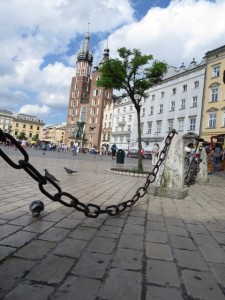 German and Flemish artists came to Krakow to pursue their art often to create the works commissioned by Polish Kings . Many came to Krakow to enjoy freedoms of expression , exercise true ability to create some extraordinary artistic treasures . Works of Wit Stwosz best represented by the wooden altar of St. Marys Church , rich tapestries by Michael van Coxcie, “the Flemish Raphael” or by Willem Tons represent some of finest example of art of the XV- XVI centuries era .
German and Flemish artists came to Krakow to pursue their art often to create the works commissioned by Polish Kings . Many came to Krakow to enjoy freedoms of expression , exercise true ability to create some extraordinary artistic treasures . Works of Wit Stwosz best represented by the wooden altar of St. Marys Church , rich tapestries by Michael van Coxcie, “the Flemish Raphael” or by Willem Tons represent some of finest example of art of the XV- XVI centuries era .
Here King Jagiello ruling from Wawel castle which was seat of Polish Kings from XI century , united Poland with Lithuania .This unity laid down basis to the concept of concord of people of Europe and made Poland one of strongest European nation of these days . Reaching lands from north by the Baltic Sea and to the south Black sea shores .
Florianska Street with its name reflects the St. Florian Patron of Firelighters reminds of the 1241 sacking of Krakow by Mongols , represents mighty days of Poland . Despite the warning of “ Hejnal” the melody concept , coming from Hungarian word “ Dawn “ and alarm played by trumpeter , to warn citizen about approaching danger of Tartar troops ,which briefly stopped by the closed gates of town , Krakow was devastated , the city has recovered . Today “ Hejnal Mariacki “ being the polish five – note tune is only expression of tradition . Welcome sound played every hour on hour to the joy and pleasure . “ Krakowiacy “ – citizens of Krakow and visitors alike love this manifestation of Polish culture . By Barbican , the only element of old fortifications of Krakow which later were transformed into “ green belt “ of “ Planty “ , so welcome part of Krakow gladly used for walks , promenades and lovers to whisper tender words of love to each other while seating on many benches along “ Planty “, presents only one short step into the Czartoryski Museum . Here beside many treasures of art , beautiful face of “Dame with Ermine “ by Leonardo da Vinci charms the visitors. It is observed by some art critics that this painting is more exiting as art creation than famous “ Mona Lisa “ . On Florianska Street one sees classical concepts of “ Kamienice “ buildings where many important institutions are housed . Jan Matejko Museum , the outstanding polish painter collection of works or “Jama Michalikowa caffe “ with mood of the “ secession era “ and many more important places await visitors. 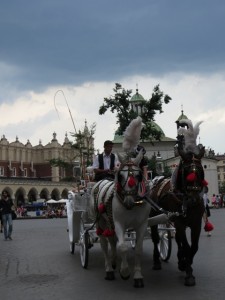
From this great street one gets into the magic of Main Square of Krakow . The jewels of St. Marys Basilica , “ Sukiennince “ Cloth Hall , St. Wojciech Church or important art places like “ Piwnica pod Baranami “ the “ Cellar under the Rams “ all to enjoy . In this beautiful square polish culinary specialities can be enjoyed , just like during hundreds of years of Krakow history . Here visitors can savour dishes of extraordinary recipes and dine in truly royal atmosphere of the interiors of many world renown restaurants . “ Pod Wierzynkiem “ Restaurant found already in XIV century , in 1364 held the famous culinary treat . Here King of Romans of Holy Roman Empire Charles IV Luxemburg met together with Casimir III Great King of Poland to dine together with other nobles of Poland and Europe , being part of “ Krakow Congress” . This event is colourfully presented by medieval French poet Guillaume de Machaut . While on walk around the Main Square the majestic structure of Adam Mickiewicz memorial can not be missed. This polish poet whose famous “ Dziady “ dramatic poem inspired Poles to keep the spirit of nationhood alive was carried in variety of artistic forms created by Stanislaw Wyspianski . His works are visible and sensed all over the town . Paintings in museums , “ stained glass “ in Churches or plays staged in Krakow Theatres . From Main Square , full of life , where youth enjoys the merry atmosphere , kids feed pigeons , flower women sale bunches of poppies , sunflower s or other colourful flowers of polish meadows and gardens many ways and basically all are leading to Wawel . This mighty Castle , symbol of thousand years of Poland . This castle stands proudly on the rocky elevation since XI century . One of ways can be via Grodzka Street where Peter and Paul Church invites to enter for a pray or via Jagielonska Street by Collegium Maius , meaning in Latin “Great College” which is oldest part of Jagellonian University and was established in XIV century . 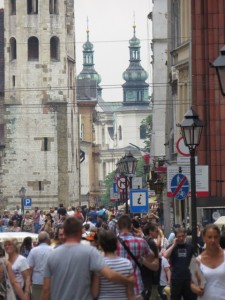
From here by is just short stroll to Kanoniczna Street , This charming street very close to many hearts of people of Krakow . Here Karol Wojtyla later Holy Father John Paul II stayed . During one of the visits to Krakow he talked to hundreds of people . Just from the window , while getting ready to night sleep he was called to appear to huge crowd , singing for him . Typical polish songs with special treat for John Paul II of singing his favoured song “ Barka “ . From Kanoniczna Street there is short walk to Wawel . It is a truly walk into rich history of Poland . Into fascinating past of Poland . Into its legends like one about Smocza Jama (Polish for “dragon’s den”) where in limestone cave supposedly nasty dragon domiciles . Wawel despite drama of Poland during WWII , like Krakow was spared the destruction , which Warsaw has suffered . Visit to Krakow is the trip into by gone eras . From this great city one can also visit Auschwitz – Concentration and Extermination camp , place of horror , designed, operated by Nazi Germany of under Hitler’s 3rd Reich . There are also, easily reachable places like Wieliczka – Salt Mines , Ojcow –part of “ Eagle Nests Route “ or Zakopane in Polish High Tara Mountains .
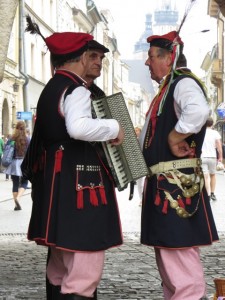 Krakow being in the southern part of Poland can be reached by trains from Vienna , Prague and Warsaw or by plane also from these cities and from Warsaw on board of LOT Polish Airlines, national carrier of Poland which together with its partners in “ Star Alliance “ like Singapore Airlines provide services from many parts of our Globe.
Krakow being in the southern part of Poland can be reached by trains from Vienna , Prague and Warsaw or by plane also from these cities and from Warsaw on board of LOT Polish Airlines, national carrier of Poland which together with its partners in “ Star Alliance “ like Singapore Airlines provide services from many parts of our Globe.
WMIG July 2014
Website sites to check :
-http://www.poland.travel/en/krakow/ – Polish Tourism website where Krakow is featured,
– http://www.lot.com/pl/en/ – LOT Polish Airlines
-http://www.singaporeair.com/SAA-flow.form?execution=e2s1 – Singapore Airlines
-http://www.mazurkas.com.pl/ – sightseeing in Krakow and also tours in surrounding areas and Poland
-http://www.mazurkas.com.pl/ – tours in Poland
-http://worldyouthday.com/- World Youth Day 2016
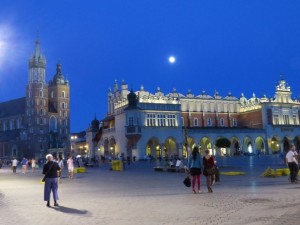
 Mitch Godziemba Swiat
Mitch Godziemba Swiat mitchgodziemba
mitchgodziemba